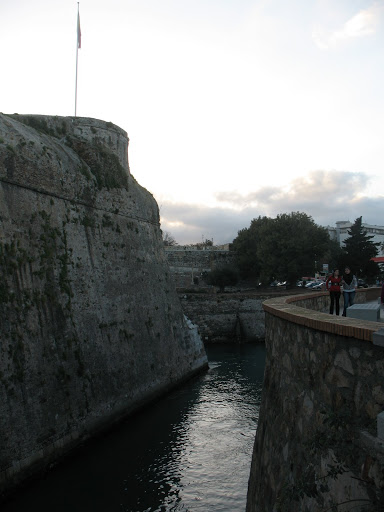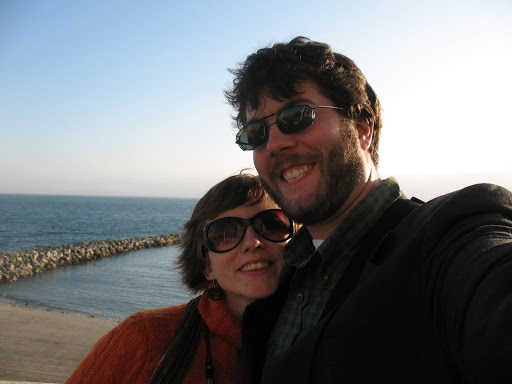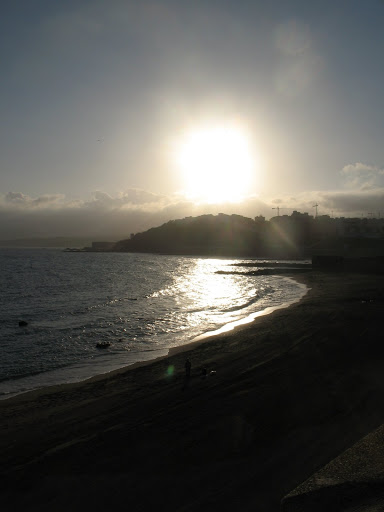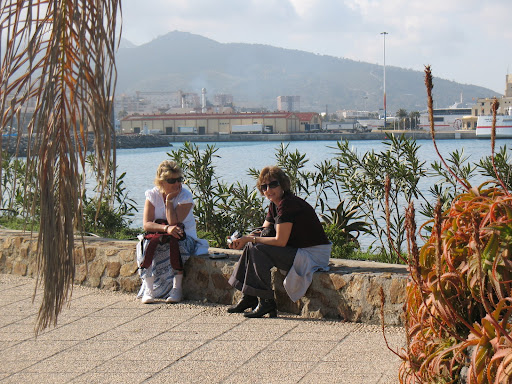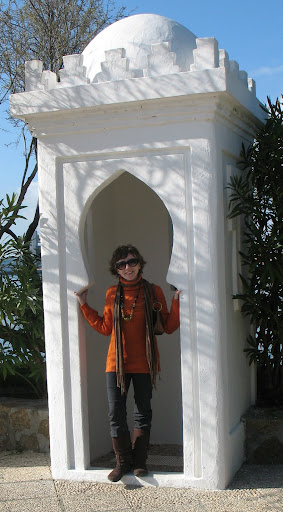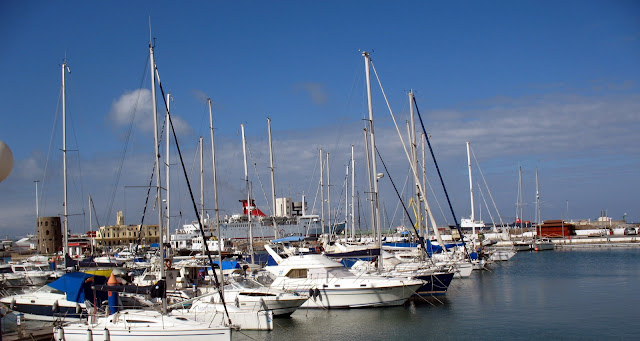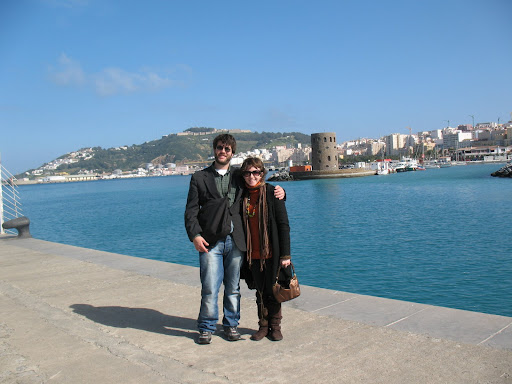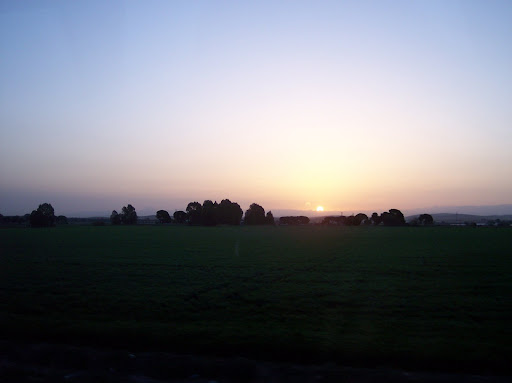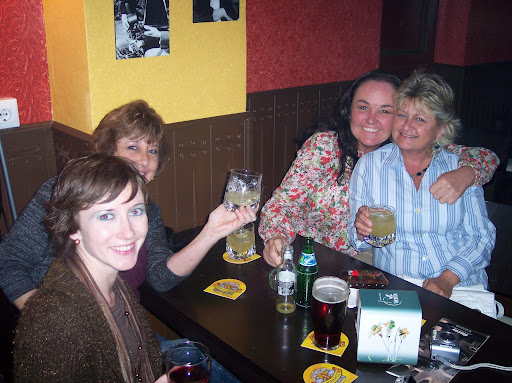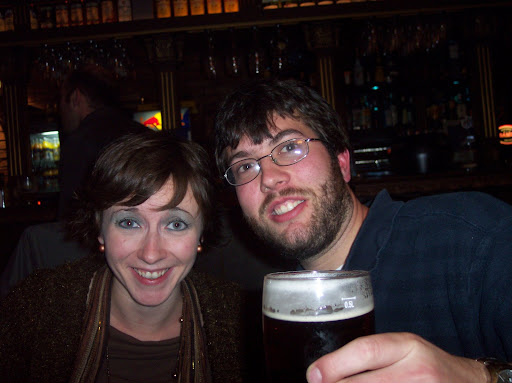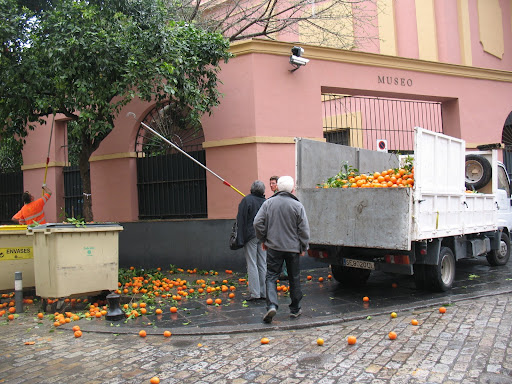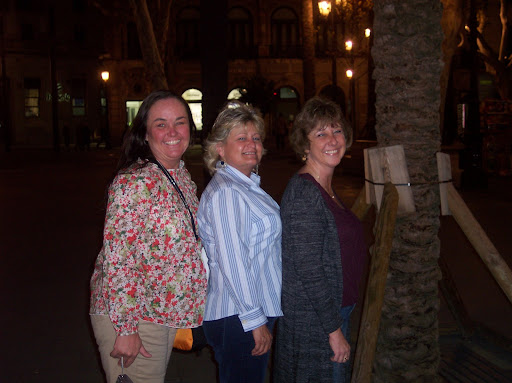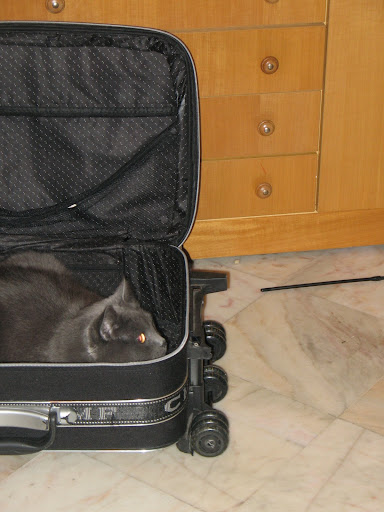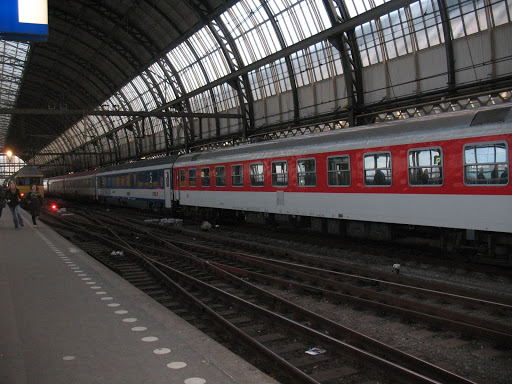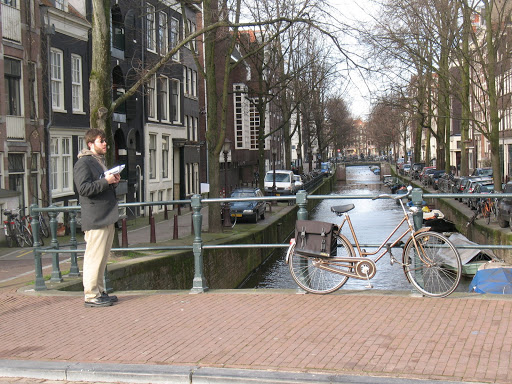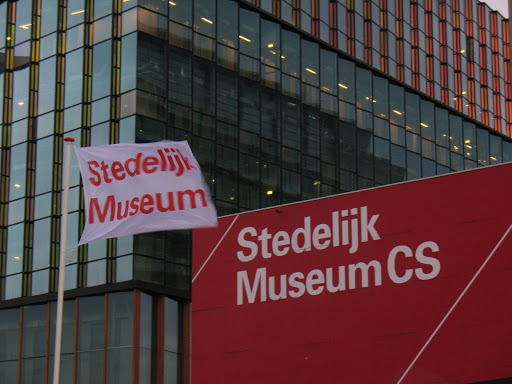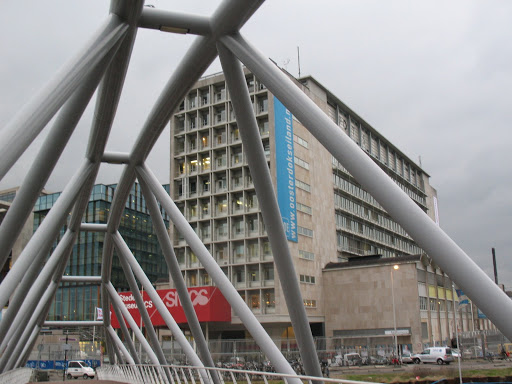 At the end of the day, we took the ferry back to Algeciras. Although we were still in Spain, we were also very close to Morocco, so “Marruecos” is also on the road sign.
At the end of the day, we took the ferry back to Algeciras. Although we were still in Spain, we were also very close to Morocco, so “Marruecos” is also on the road sign.
Wednesday, February 27, 2008
Back to Algeciras
 At the end of the day, we took the ferry back to Algeciras. Although we were still in Spain, we were also very close to Morocco, so “Marruecos” is also on the road sign.
At the end of the day, we took the ferry back to Algeciras. Although we were still in Spain, we were also very close to Morocco, so “Marruecos” is also on the road sign.
North Bay—Atlantic Coves
Botanical Gardens
Us in the park
Parque Marítimo del Mediterráneo

 Our first stop in Ceuta
Our first stop in Ceuta Off in the distance, you could see the Pillars of Hercules as well. Pomponius Mela once said in 1 B.C. that there were two mountains, one called Abyla (Ceuta) and the other Calpe (Gibraltar). Together they made up the Pillars of Hercules. Legend has it that Hercules separated the two peaks that had previously been joined by a continuous mountain range while searching for the Cattle of Geryon. Upon separating the two mountains, the ocean rushed in, flooding the space it now occupies between the two cities.
Monday, February 25, 2008
In Ceuta at last!
Docking in Ceuta
 The European Union, Spanish, and Ceutan flags are the first to welcome you to Northern Africa.
The European Union, Spanish, and Ceutan flags are the first to welcome you to Northern Africa.The waters across the Strait of Gibraltar are particularly rough due to the strong currents from both the Atlantic and the Mediterranean. After fighting off seasickness for nearly an hour, I have never been so glad to see land in all of my life!
Saturday, February 23, 2008
Strait of Gibraltar
Friday, February 22, 2008
Hostal Marrakech
 The first weekend that Madre and her buddies were here in town, we took a bus to Alegeciras. From there, we had a good starting point to travel to Gibraltar and Ceuta.
The first weekend that Madre and her buddies were here in town, we took a bus to Alegeciras. From there, we had a good starting point to travel to Gibraltar and Ceuta. Our hostal was called the Hostal Marrakech, which is run by a Morrocan family. This picture is an example of the tilework that is found inside.
Bus to Algeciras
Brown Sugar Bar
Grooming the Orange Trees
Madre & Co.
Polytechnic School at the University of Seville
Thursday, February 21, 2008
Back to Sevilla!
Wednesday, February 20, 2008
Nationaal Monument
 Across the street from the large Dam Square where the Koninklijk Paleis stands is the Dutch Nationaal Monument. Unveiled on May 4, 1956, it honors Dutch victims of WWII. Interestingly enough, there is soil from each of Holland’s 12 provinces as well as the Dutch East Indies inside the 21m white-stone obelisk.
Across the street from the large Dam Square where the Koninklijk Paleis stands is the Dutch Nationaal Monument. Unveiled on May 4, 1956, it honors Dutch victims of WWII. Interestingly enough, there is soil from each of Holland’s 12 provinces as well as the Dutch East Indies inside the 21m white-stone obelisk.
Koninklijk Paleis
Sint Nicolaaskerk
 The church across the canal in this photo is the Sink Nicolaaskerk. Erected in 1887 by A.C. Bleys to honor the patron saint of sailors, it replaced many secret Catholic churches formed after the Calvinists took power and ordered the Catholic icons to be abolished in the 1570s.
The church across the canal in this photo is the Sink Nicolaaskerk. Erected in 1887 by A.C. Bleys to honor the patron saint of sailors, it replaced many secret Catholic churches formed after the Calvinists took power and ordered the Catholic icons to be abolished in the 1570s.The architecture is designed in a neo-Renaissance style with black marble columns, a domed ceiling, and wooden vaults. Although it is impossible to see in this picture, the bursts of color of the stained-glass work in the church is very impressive.
Waag
 The next morning, while we were wandering around just before heading home, we stopped by the Waag to take a few pictures. It is located in Nieuwmarkt, which is the square on the border between the Oude Zijde and the Jodenbuurt. The Waag is Amsterdam's largest surviving medieval building dating from the 15th century and was one of the city's fortified gates which later housed the Surgeons Guild's amphitheater. Public dissections and private anatomy lessons once took place there, as indicated by Rembrandt's The Anatomy Lesson of Dr. Tulp.
The next morning, while we were wandering around just before heading home, we stopped by the Waag to take a few pictures. It is located in Nieuwmarkt, which is the square on the border between the Oude Zijde and the Jodenbuurt. The Waag is Amsterdam's largest surviving medieval building dating from the 15th century and was one of the city's fortified gates which later housed the Surgeons Guild's amphitheater. Public dissections and private anatomy lessons once took place there, as indicated by Rembrandt's The Anatomy Lesson of Dr. Tulp.
Heineken
Bicycles galore

 Because the Netherlands is such a small country, most everything is accessible by bike. Despite what I thought were frigid temperatures and gusty winds, we saw many of Amsterdam's residents with frostbit cheeks as they rode their bicycles from one place to another. Honestly, as Brian and I made our way around the city by foot, we were more careful on the bike lanes than the roads themselves because we were almost mowed down by the bicycles on more than one occasion.
Because the Netherlands is such a small country, most everything is accessible by bike. Despite what I thought were frigid temperatures and gusty winds, we saw many of Amsterdam's residents with frostbit cheeks as they rode their bicycles from one place to another. Honestly, as Brian and I made our way around the city by foot, we were more careful on the bike lanes than the roads themselves because we were almost mowed down by the bicycles on more than one occasion.To give you an idea of just how many bikes there are in the city, check out this multi-level parking garage packed full of them!
Vondelpark

 After a long day, we decided that we needed to rest in the park before doing anything else. Vondelpark is famous for its meandering walkways, green meadows, several ponds, and a pathway which extends 1.5 km for bikers and skaters. This English-style park is the largest in the city's center and is named after 17th-century poet and playwright Joost van den Vondel.
After a long day, we decided that we needed to rest in the park before doing anything else. Vondelpark is famous for its meandering walkways, green meadows, several ponds, and a pathway which extends 1.5 km for bikers and skaters. This English-style park is the largest in the city's center and is named after 17th-century poet and playwright Joost van den Vondel.
Van Gogh Museum

 The last stop on our schedule for the day was the Van Gogh Museum, which boasts of the largest collection of van Goghs in the world. My favorite piece was "Sunflowers," which has always been my favorite of van Gogh due to my personal bias for the flower. The museum also features a diverse group of 19th-century paintings by other artists of the time that van Gogh admired, such as Gaughin and Emile Bernard.
The last stop on our schedule for the day was the Van Gogh Museum, which boasts of the largest collection of van Goghs in the world. My favorite piece was "Sunflowers," which has always been my favorite of van Gogh due to my personal bias for the flower. The museum also features a diverse group of 19th-century paintings by other artists of the time that van Gogh admired, such as Gaughin and Emile Bernard.It was truly an amazing experience being able to see so many famous works of art firsthand.
Sunday, February 17, 2008
Rijksmuseum

 Our next stop for the day was the Rijksmuseum, which is an art museum that houses an impressive collection from the Dutch Golden Age. We must have seen millions of dollars worth of art, including works by Rembrandt and Vermeer. In fact, Rembrandt's famous piece entitled "The Nightwatch" was on display.
Our next stop for the day was the Rijksmuseum, which is an art museum that houses an impressive collection from the Dutch Golden Age. We must have seen millions of dollars worth of art, including works by Rembrandt and Vermeer. In fact, Rembrandt's famous piece entitled "The Nightwatch" was on display.
Tuesday, February 5, 2008
Westerkerkstoren Tower
 As we were walking, we passed this tower which is part of the Westerkerk Protestant church located near the Anne Frank Huis. It was designed by Roman Catholic architect Hendrick de Keyser and completed in 1631. It is actually one of the last buildings designed in the Dutch Renaissance style, with the typical mix of brick and stone.
As we were walking, we passed this tower which is part of the Westerkerk Protestant church located near the Anne Frank Huis. It was designed by Roman Catholic architect Hendrick de Keyser and completed in 1631. It is actually one of the last buildings designed in the Dutch Renaissance style, with the typical mix of brick and stone.
On the Road Again...
Anne Frank Huis

 The next morning, we decided to hit some of the other museums in Amsterdam. To start off the day, we went to the Anne Frank Huis, where Anne Frank wrote her famous diary during WWII. Anne Frank and her family, along with another Jewish family, lived in a secret annex in hiding from July 6, 1942 to August 4, 1944, when the building was stormed by the German Security Police. Upon their discovery, everyone in hiding was seized and deported to various concentration camps. Unfortunately, Otto Frank, Anne's father, was the only one who was able to survive the horrors of life at the mercy of Nazi Germany. Anne died of typhus in Bergen-Belsen just one month before the Allied victory in early March of 1945.
The next morning, we decided to hit some of the other museums in Amsterdam. To start off the day, we went to the Anne Frank Huis, where Anne Frank wrote her famous diary during WWII. Anne Frank and her family, along with another Jewish family, lived in a secret annex in hiding from July 6, 1942 to August 4, 1944, when the building was stormed by the German Security Police. Upon their discovery, everyone in hiding was seized and deported to various concentration camps. Unfortunately, Otto Frank, Anne's father, was the only one who was able to survive the horrors of life at the mercy of Nazi Germany. Anne died of typhus in Bergen-Belsen just one month before the Allied victory in early March of 1945.The museum documents her life during her years in hiding and has the actual diary on display, which is admirably optimistic with only hints of what must have been unsurmountable despair.
Today, the museum is just as it was when Anne and her family spent their last days there. The original furniture has been removed, but you can still see the pictures of 1940s movie stars and a young Queen Elizabeth adorning the walls of her narrow room. Even the pencil marks that Anne's mother, Edith Frank, made on the walls to denote the heights of her children are still preserved.
The top picture is of the house itself, which is located directly on the Prinsengracht, one of the many canals dissecting the city. The lower picture is probably what the view was like from inside the annex for its residents during their 25 months in hiding.
Sunday, February 3, 2008
Red Light District
 After spending the day in the museum marveling over art, we went to the Red Light District to take in a different sort of spectacle. When night falls, the area actually glows red. Sex theaters throw open their doors and the streets are packed with people gawking at the scantily-clad prostitutes propositioning passers-by from black-lit windows. The profession is legal in the Netherlands, with a number of security measures in place to prevent violence against the women, STDs, etc.
After spending the day in the museum marveling over art, we went to the Red Light District to take in a different sort of spectacle. When night falls, the area actually glows red. Sex theaters throw open their doors and the streets are packed with people gawking at the scantily-clad prostitutes propositioning passers-by from black-lit windows. The profession is legal in the Netherlands, with a number of security measures in place to prevent violence against the women, STDs, etc.Most of the sex workers are women. Ironically, a few years back three men attempted to follow the lead of their female colleagues. The men positioned themselves in a window, but they were instructed not to quit their day job because the women were simply not taking their bait. One of the female prostitutes even described the incident as "filthy." Talk about the pot calling the kettle black! Ouch!
Stedelijk Museum of Modern Art
Hotel
 Our hotel was very centrally located, directly facing the Oosterdok waterway. Our room was on the third floor, so the view of the city was absolutely amazing. If you look at where all of the flags are at the base of the buildings, there is a "hotel" sign just to the left for Y Boulevard, which is where we stayed. The window to our room was the second one above the sign.
Our hotel was very centrally located, directly facing the Oosterdok waterway. Our room was on the third floor, so the view of the city was absolutely amazing. If you look at where all of the flags are at the base of the buildings, there is a "hotel" sign just to the left for Y Boulevard, which is where we stayed. The window to our room was the second one above the sign.
Amsterdam
 To take advantage of the break in between the two semesters, Brian and I went to Amsterdam from January 30th until February 2nd to meet Grey, a good friend of ours who lives in Portland, Oregon. We flew in late Wednesday evening and took a train to Centraal Station, where we began the walk to our hotel just a few blocks away.
To take advantage of the break in between the two semesters, Brian and I went to Amsterdam from January 30th until February 2nd to meet Grey, a good friend of ours who lives in Portland, Oregon. We flew in late Wednesday evening and took a train to Centraal Station, where we began the walk to our hotel just a few blocks away.
Saturday, February 2, 2008
Dublin, Ireland
Boom Femenino in Mexico: Reading Contemporary Women's Writing


During the conference, I had the opportunity to meet a number of colleagues in the field in addition to Ana Clavel, a contemporary Mexican writer who is currently residing in Mexico City. The top picture is of Ana and I just before the close of the conference, and the group picture below was shot directly after all of the concluding remarks.
Subscribe to:
Comments (Atom)
